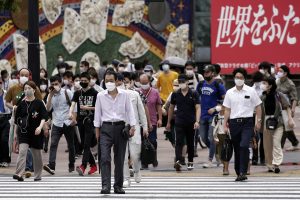Japan’s highly praised earlier success in containing the coronavirus outbreak has started to unravel, with a flare up of coronavirus infections nationwide proving far more aggressive than the initial outbreak in April. Tokyo has become a major hotspot, with an upward trend in July sparking fears of an impending second wave.
For 10 consecutive days, the daily new case count in Tokyo has hovered around 200, excluding July 27. The count surged to a record-setting 450 infections last Friday and 472 new infections on Saturday. With over 14,000 active coronavirus infections in Tokyo, hospitals are gearing up for a rapid surge in seriously ill patients, but it’s unclear whether Japan and in particular Tokyo will be able to weather the latest outbreak. The central government seeks to balance restoring economic consumption with maintaining its reputation as a safe host for the postponed 2020 Tokyo Olympic Games.
Although roughly half of new positive infections remain untraceable, an alarming infection pattern has emerged with clusters detected among households, sporting groups, university dormitories, and corporate offices on top of the infections traced back to eateries, bars, and karaoke venues. In Tokyo, people in their 20s and 30s accounted for 62 percent of Tuesday’s new cases, and authorities are urging younger generations to consider the lives of vulnerable groups such as elderly family members and senior citizens.
Coronavirus fatigue may have contributed to a general complacency around social distancing during Japan’s four day weekend starting July 23.
As school summer holidays begin and families prepare to return to their hometowns to celebrate the traditional Obon custom of honoring one’s ancestors, Tokyo Governor Yuriko Koike has reinitiated calls to restrict nonessential outings and trips between prefectures, measures that were first introduced under a state of emergency in April. The central government has since maintained efforts to cautiously reopen the economy and has resisted a return to stay at home measures that will further dampen economic recovery. But Koike warned that a state of emergency might be declared in Tokyo if the current trend continues unabated.
In an effort to contain the spread of coronavirus, Koike called for karaoke venues and bars in Tokyo to close by 10 p.m. from Monday until the end of August. A cash bonus of $1,900 has been offered to businesses that comply with temporary business closure requests.
Japan’s southernmost tropical island of Okinawa declared its own two week state of emergency on Saturday in an effort to prevent the collapse of its health care system.
As of Monday, 2,400 hospital beds in Tokyo have been designated for coronavirus patients, with 100 hospital beds set aside for seriously ill patients. However, the number of patients requiring hospitalization grew by 50 between Sunday and Monday, reaching a total of 1,365. If it continues, that rapid rise could risk a health care collapse. Meanwhile, the number of COVID-19 patients requiring in-home treatment also grew by 135, to a total of 524.
The current uptick in coronavirus cases nationwide coincides with the government’s controversial “Go To” domestic travel subsidy campaign, which has come under fire for not only the initial budget blowout and allegations of corporate favoritism but for also irresponsibly pushing local tourism during an unpredictable public health crisis. With the government working to accelerate a much-needed economic boost, the campaign, which officially launched on July 22, has placed many would-be domestic tourists in a dilemma: They can score a 50 percent discount, but risk potentially leaving a trail of coronavirus infections in areas without urban health care facilities. Some Twitter users and celebrities called for the campaign to be cancelled while others mocked the campaign as a “Go To Hospital” death trap.
In an effort to prevent a second wave of infections, the Health Ministry launched a coronavirus contact tracing app on June 19, amid a debate over privacy concerns. Despite some 9.5 million downloads, only 76 positive cases were registered on the app, calling attention to the need for greater public motivation and cooperation as a foundation for efficient prevention measures.
Japan’s initial low infection rate and death toll was hailed as a puzzling pandemic success story. After emerging from a national state of emergency in mid-May, experts were baffled by how Japan managed to escape a public health care crisis amid an ultra aging society with high urban population density. Unlike strict lockdowns seen in Europe, the central government’s highly controversial approach to containing the spread of coronavirus through largely voluntary self restrictions, social distancing, and limited PCR testing was dubbed a coronavirus “miracle” in local and international media.

































